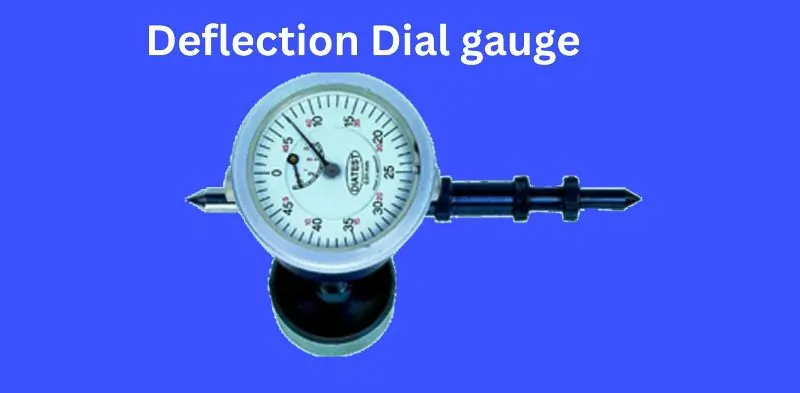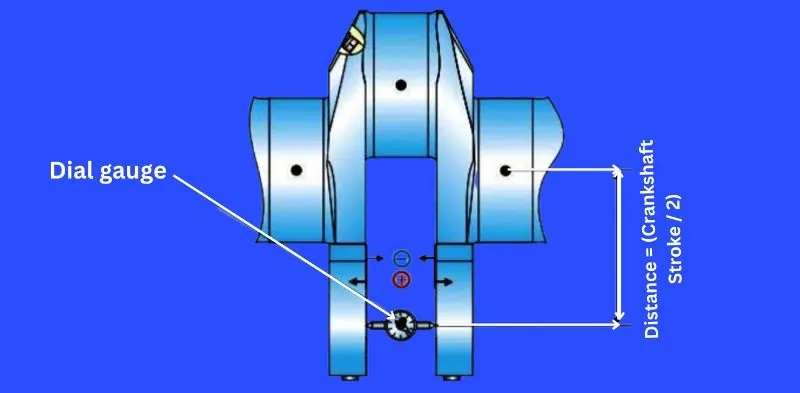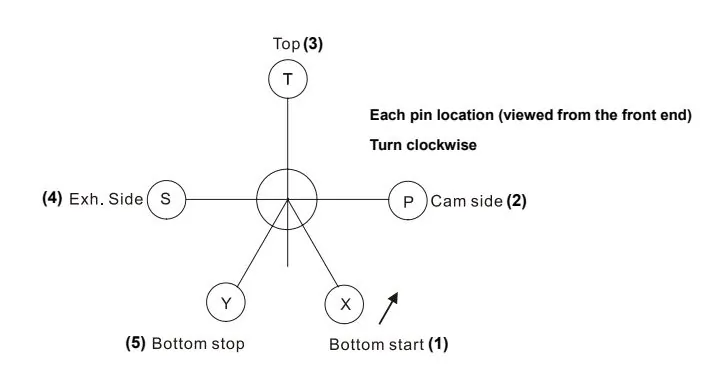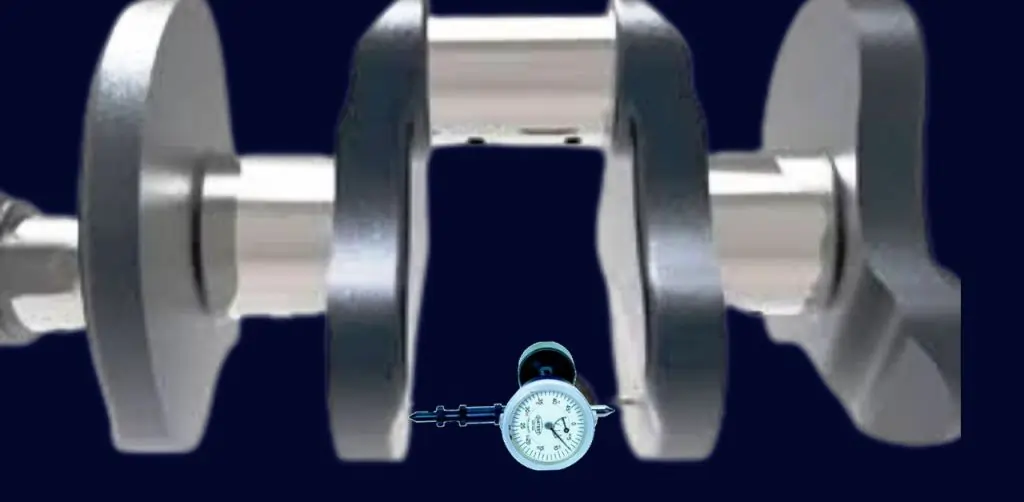Crankshaft Deflection
Crankshaft deflection occurs when the crankshaft in a Marine Diesel Engine bends or misaligns due to uneven load distribution, bearing wear, or improper maintenance. Over time, this deflection can lead to excessive vibrations, abnormal wear on bearings, and even catastrophic engine failure if not properly addressed. Understanding crankshaft deflection is crucial for maintaining engine longevity and ensuring peak efficiency.
In this tutorial, we’ll explore the key causes of crankshaft deflection, how to measure and detect it using the right tools, and the potential effects it can have on your engine. You’ll also learn best practices for preventing deflection, maintaining proper alignment, and the steps needed to correct minor issues before they become major problems. By the end, you’ll have the knowledge to keep your Marine Diesel Engine running smoothly and efficiently, avoiding costly repairs and downtime.
What is Crankshaft Deflection?
Crankshaft deflection refers to the slight bending or misalignment of a crankshaft during operation. It occurs when the crankshaft is subjected to uneven forces or stresses, leading to a deviation from its optimal alignment.
Causes of Crankshaft Deflection
- Misalignment: When the main bearings or other components are improperly aligned, the crankshaft can experience uneven forces, causing it to deflect.
- Bearing Wear: Excessive wear on engine bearings can cause instability in the crankshaft’s position, leading to deflection.
- Thermal Expansion: High engine temperatures can cause the crankshaft or its surrounding components to expand, resulting in deflection over time.
Why Crankshaft Deflection Matters
Crankshaft deflection affects engine performance by increasing wear on components, creating vibrations, and reducing overall efficiency. Left unchecked, it can lead to severe engine damage, including crankshaft failure, costly repairs, and downtime. Understanding and addressing deflection early is essential for maintaining engine health and avoiding critical failures.
Symptoms and Effects of Crankshaft Deflection
Symptoms of Crankshaft Deflection
- Abnormal Vibrations: One of the most noticeable signs of crankshaft deflection is increased vibrations during engine operation. These vibrations can be felt through the engine and may worsen over time.
- Irregular Wear on Bearings: Excessive or uneven wear on the engine’s main and connecting rod bearings can indicate that the crankshaft is not aligned properly, leading to deflection.
Effects on Marine Diesel Engines
- Reduced Efficiency: A deflected crankshaft creates additional friction and resistance, reducing the engine’s overall efficiency and increasing fuel consumption.
- Risk of Crankshaft Failure: Prolonged deflection can weaken the crankshaft, making it more susceptible to cracks or complete failure, resulting in costly repairs and extended downtime.
Impact on Other Engine Components
Crankshaft deflection places extra stress on components like the connecting rods and pistons, causing uneven wear and potentially leading to damage. This can further compromise engine performance and longevity if not addressed early.
Measuring Crankshaft Deflection
Tools Required for Measuring Deflection

- Deflection Gauge: A tool designed to measure the crankshaft’s deflection.
- Dial Indicators: Precision instruments for accurate measurement of small displacements.
Step-by-Step Process for Measuring Deflection

Step-by-Step Process for Measuring Crankshaft Deflection
Fig2

- Mount the Dial Gauge:
- Install the dial gauge between the two crank webs of the last cylinder nearest to the flywheel, as shown in the diagram.
- Rotate the Crankshaft to Measuring Position 1:
- Turn the crankshaft to the first measuring position, which is typically at top dead center (TDC) of the cylinder, as illustrated in Fig. 2.
- Set the Dial Gauge to Zero:
- Adjust the dial gauge to read zero at measuring position 1.
- Rotate the Crankshaft and Record Values:
- Rotate the crankshaft through measuring positions 2, 3, 4, and 5. Take readings at each position using the dial gauge, and record these readings for further evaluation.
- Evaluate the Readings:
- a) The reading at measuring position 5 should be close to the reading at position 1. If there is a large difference between these readings, repeat steps 2 to 5.
- b) Calculate Vertical and Horizontal Deflections:

Important Notice
If the calculated vertical or horizontal deflections exceed the permissible limits, realignment of the engine and the driven machinery is necessary. Before realigning, check the main bearing metals for abnormal wear. Always consult the engine manufacturer’s after-sales service (A/S) department for guidance on realignment.
- Re-check After Realigning:
- After the crankshaft and machinery have been realigned, repeat steps 1 to 5 to confirm the deflection is within permissible limits.
Permissible Deflection Limits
Permissible Deflection Formula:

This formula gives a general permissible deflection limit, expressed in millimeters, for many types of large marine diesel engines. If the actual measured deflection exceeds this limit, realignment or repair is required.
Important Note:
Always refer to the specific manufacturer’s manual for the exact permissible deflection limits, as they may provide detailed and more precise values tailored to the engine model and operating conditions.
Causes of Crankshaft Deflection in Marine Diesel Engines
1. Poor Alignment of Main Bearings
When the main bearings are not properly aligned, the crankshaft is subjected to uneven forces. This misalignment causes the crankshaft to bend or deflect from its optimal position, leading to stress on the engine components and reducing overall efficiency. Regular alignment checks are essential to prevent this issue.
2. Uneven Load Distribution and Stress on the Crankshaft
Marine Diesel Engines often experience varying loads, especially in harsh operating environments. When the load distribution is uneven, the crankshaft endures disproportionate stress, causing deflection. This can happen due to improper engine load balancing, fluctuations in torque, or operational conditions like frequent speed changes.
3. Excessive Bearing Wear or Improper Bearing Installation
Worn-out or improperly installed bearings fail to support the crankshaft adequately, leading to its instability. Excessive bearing wear increases the clearance between the crankshaft and bearings, making the crankshaft prone to deflection. Ensuring proper bearing installation and timely replacement is crucial to prevent crankshaft misalignment and deflection.
Preventing Crankshaft Deflection
1. Routine Maintenance Tips
Regular maintenance is key to preventing crankshaft deflection. Start with bearing inspection to ensure they are in good condition and free from excessive wear. Alignment checks should also be performed routinely to confirm that the main bearings are properly aligned with the crankshaft, reducing the risk of uneven forces that cause deflection. These checks should be part of the engine’s scheduled maintenance program to ensure optimal performance.
2. Importance of Proper Lubrication and Cooling Systems
The lubrication system plays a critical role in minimizing friction and wear on the crankshaft and bearings. Ensure the system is functioning correctly, using the recommended oil and maintaining the correct oil pressure and flow. Additionally, a well-maintained cooling system helps prevent excessive thermal expansion, which can cause the crankshaft to deflect under heat. Regularly check for leaks, and ensure coolant levels are sufficient.
3. Regular Monitoring and Early Detection Strategies
Regular monitoring of the crankshaft’s performance and early detection of potential issues can prevent deflection from worsening. Use vibration analysis and deflection measurement tools to track the crankshaft’s condition. Detecting and addressing minor misalignments or bearing wear early can prevent major engine damage and costly repairs down the line.
Repairing and Correcting Crankshaft Deflection
1. Solutions for Correcting Minor Deflection Without Disassembly
Minor crankshaft deflection can often be corrected without engine disassembly. This includes adjusting bearing clearances or performing realignment checks. Regular deflection measurements help detect small issues that can be fixed by adjusting engine operation, such as load balancing or improving the lubrication and cooling systems. These adjustments can alleviate minor deflection before it becomes a significant problem.
2. When Should You Consider Replacing Bearings or Performing Major Repairs?
If deflection exceeds acceptable limits or there are signs of excessive wear on bearings, oval or tapered crankshaft journals, or visible cracks, major repairs are required. One of the critical repair solutions involves grinding the crankshaft journals to remove ovality (uneven roundness) or taperism (uneven diameter along the journal). This process smooths out the journal surface and brings it to the next repair stage, ensuring optimal alignment. After grinding, bearings must be replaced according to the new journal diameter, following the manufacturer’s specifications for repair sizes.
3. Balancing and Realigning the Crankshaft After Deflection Correction
After journal grinding and bearing replacement, it’s essential to balance and realign the crankshaft to ensure proper operation. Balancing prevents excess vibration and future deflection, while realigning ensures that the crankshaft works in harmony with the bearings and other engine components. Proper realignment and balancing improve the engine’s efficiency and prevent premature wear, thereby extending the life of the crankshaft and bearings.
Best Practices for Ensuring Long Crankshaft Life
1. Key Maintenance Routines for Avoiding Deflection
Regular maintenance is critical to preventing crankshaft deflection and extending its lifespan. Begin with routine deflection measurements using a deflection gauge to catch early signs of misalignment. Check bearing conditions frequently to ensure they are in good shape and properly aligned. Additionally, maintaining lubrication systems is essential to avoid unnecessary friction and wear. Lastly, ensure the engine operates under balanced load conditions, which reduces stress on the crankshaft.
2. How to Properly Install and Maintain Bearings to Reduce Stress
Proper bearing installation is crucial for minimizing crankshaft stress. During installation, ensure that bearings are aligned precisely with the crankshaft journals to avoid uneven load distribution. Use the correct bearing clearances as per the manufacturer’s guidelines, and regularly inspect the bearings for wear or damage. Periodic bearing replacement is also recommended to prevent excessive wear that could lead to deflection.
3. Long-term Strategies for Preserving Crankshaft Integrity
For long-term crankshaft integrity, implement a structured maintenance schedule that includes deflection checks, bearing inspections, and proper lubrication. Monitoring engine performance and load conditions is vital in detecting any anomalies that might indicate potential deflection. Regular rebalancing and realignment of the crankshaft, along with addressing thermal expansion effects, will help ensure that the crankshaft maintains its optimal shape and alignment, thus prolonging its service life in Marine Diesel Engines.
FAQ on Crankshaft Deflection
Q- What is crankshaft deflection?
A- Crankshaft deflection is the bending or misalignment of the crankshaft due to uneven forces or wear.
Q- What causes crankshaft deflection?
A- It is caused by misaligned bearings, excessive bearing wear, thermal expansion, or uneven load distribution.
Q- How is crankshaft deflection detected?
A- It’s detected using a deflection gauge to measure any misalignment in the crankshaft.
Q- How can crankshaft deflection be prevented?
A- Regular inspections, proper bearing alignment, and maintaining balanced loads can help prevent deflection
Conclusion
In summary, crankshaft deflection in Marine Diesel Engines can lead to serious engine performance issues, including abnormal vibrations, uneven wear on bearings, reduced efficiency, and even complete crankshaft failure. Regular inspections, proper bearing maintenance, and early detection of deflection are essential in preventing costly repairs and minimizing downtime.
By following best practices such as routine deflection measurements, proper bearing installation, and maintaining balanced engine loads, you can significantly extend the life of your crankshaft. Proactive maintenance and early intervention are crucial—addressing deflection at its early stages helps avoid more severe damage and ensures that your engine operates smoothly and efficiently for years to come.
